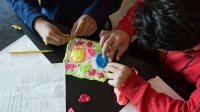Playing to Learn in Middle and High School
Play-based learning can help older students remember new material and transfer their learning from one context to another.
Your content has been saved!
Go to My Saved Content.Play is valued at the elementary level, yet it’s rarely discussed at the middle and high school levels. A strong advocate of playing to learn is Peter Gray, a professor at Boston College, who discusses the importance of play for children and adults. In Free to Learn, Gray defines play as including elements of imagination, self-direction, and an experience in which the means are valued over the ends.
Since play centers around curiosity and stems from self-direction, let’s explore ideas about what conditions can be set up to foster play in the content-area classroom.
Set Up for Play
Imagine what your students would do if you paused a lesson and asked them to use Play-Doh to construct a scientific or mathematical understanding or concept they have learned.
To start, let’s look at how we can provide objects like Play-Doh for student play. Aside from creating something on a large scale like what architect David Rockwell designed years ago, let’s simply look at the resources that may exist within our school or classroom.
As a suggestion, middle and high school teachers can plan instruction with physical classroom materials such as sidewalk chalk, thread, Lego pieces, paints, glitter, Play-Doh, rods and connectors, puppets, games, and more. These materials inspire hands-on, creative activities that allow students to express their learning in different ways.
When teachers use an array of materials to encourage playing to learn, students tend to remember their learning better as they are called upon to use multisensory and self-directed means. This learning will stick with embedded reflective exercises as students consider the process of play in light of their learning. Such materials allow students to make their understanding or ideas come to life as they design by hand.
Utilizing Resource Stations
Across content areas, teachers may leave resources out and set aside time to play to learn. Hands-on materials can be used to make sense of learning, resulting in varying products based on how each student processes their knowledge.
For instance, try creating resource stations for students to play with their ideas.
Three examples of stations could include an “artist’s station” with construction paper, an easel markerboard, glitter, paints, clay, and other tools; a “set it in motion station” with socks (possible creation of sock puppets), frozen pop sticks, string, stickers, thread, markers, and empty tissue boxes; and a “build it station” with thread, beads, yarn, rods and connectors, and Legos. Students choose the station based on the materials that inspire them to play and create.
After they complete these stations, students can be asked to reflect on what they created, possibly by writing, talking with a partner, or completing an exit ticket.
With this information, the teacher can use play outcomes and reflections as assessments to inform instruction, then continue to design opportunities for play to deepen learning.
The Value of Play
Creating by hand may increase the depth of understanding by promoting transfer. Students re-create learning through a physical modality to see how they understand their knowledge.
For instance, an English teacher can give out Lego bricks to students and ask them to think about their learning as they play or build with the pieces. Students may create scenes from a book that depict plot, a structure that portrays the theme of the book, or possibly even a symbol that represents a character’s internal traits.
Often, the use of manipulatives in play, over traditional assignments, is more abstract, which leads to conceptual or higher-level learning that may result in students asking more questions, seeing where their understanding could be muddy, or endeavoring to make a cross-curricular connection for a deeper knowledge.
An added benefit is how students gain a better understanding of the time it takes to create with one’s hands and the beauty it delivers to the community. Designing by hand is one of the best ways to build a trusting, caring, and warm learning environment. Consider the examples above. In order for the experience of playing to learn to occur, students must be comfortable in the environment to take this risk with play as an adolescent.
Most often in the middle and high school environment, students receive specific, direct instructions on what they need to learn, why, and how to measure their efforts. This openness to explore and play with thinking by creating something is less common. There is no learning objective and no success criteria for students to monitor; rather, there is an invitation to play, to unearth new ideas and questions, to explain knowledge in a conceptual and unique manner, or to simply make personal connections that may help to better define themselves as learners.
With limited time and a demanding content curriculum driving each course, teachers can consider what could be removed to try out playing to learn. Your students will remember it as you afford them the opportunity to hold tight to their natural inclination to play. They may realize the important role that play assumes and how it is a treasure we should use to thrive well into old age.
